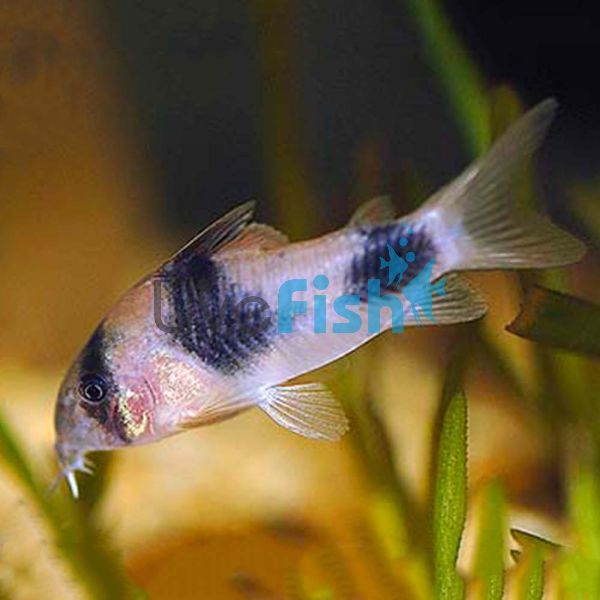Weitzmani Two Saddle Corydoras 3cm
The Corydoras Weitzmanni is a stunning, contrasting, and absolutely adorable species that is quite underrated. They make for a beautiful alternative to the more common Corydoras species such as panda cories or peppered corydoras and a great segway into the higher-end corydoras species. This particular species only reaches around 5 cm which makes them absolutely perfect for smaller aquariums and they are surprisingly easy to care for. Given the right environmental conditions they will also breed in the home aquarium and make for a great breeding project but they can also just be enjoyed in a community setting.
- Buy 4 for $33.34 each and save 10%
- Buy 6 for $29.63 each and save 20%
Weitzmani Two Saddle Corydoras
The Corydoras Weitzmanni is a stunning, contrasting, and absolutely adorable species that is quite underrated. They make for a beautiful alternative to the more common Corydoras species such as panda cories or peppered corydoras and a great segway into the higher-end corydoras species. This particular species only reaches around 5 cm which makes them absolutely perfect for smaller aquariums and they are surprisingly easy to care for. Given the right environmental conditions they will also breed in the home aquarium and make for a great breeding project but they can also just be enjoyed in a community setting.
Corydoras Weitzmanni has a very similar body shape to more common species but where they differ is in their colouration. The body colour of this fish is a semi-translucent pink colour which is quite unique to their fish. Whilst in some individuals it can be whiter, the pinkish body colour is quite recognizable with this species. They also have a band that goes vertically through the eye and two thick saddle-like patches on the body which fall directly under the dorsal fins. The cheeks of the two saddle corydoras also have a light jade green sheen which seems to be a common factor amongst nearly all corydoras.
Just like any other corydoras species the two saddle corydoras constantly stir the substrate layer in order to look for food. They are almost exclusively bottom-dwelling fish and are an awesome option to add some life to the bottom of the tank. The two saddle corydoras are not a shy species either and are quite active, making them great and popular fish for the community and planted aquariums. These fish are also considered to be a schooling catfish, in the wild they are often seen in large groups however in the home aquarium it is recommended to keep at least 3 or more. An ideal school would be around 6 plus individuals to really make them feel comfortable and to add some activity to the tank.
Due to their newer entrance into the Australian aquarium hobby, there are not a lot of recorded breeding attempts however the process should be fairly easy, as other corydoras species have been bred in captivity. Differentiating males and females is possible where the males are often smaller and narrower compared to the larger-bodied females. The best method to identify is to get a pack of 4-6 two saddle corydoras and let a pair naturally form. Females are often triggered to spawn after being fed high-quality food and a slight reduction in the temperature. The wild origin of the corydoras Weitzmanni is South America.
Tank Recommendations for your Corydoras Weitzmanni
As two saddle corydoras reach around 5 cm as adults it is best to keep them in an aquarium with a minimum size of around 700 litres. A larger aquarium will always be better due to their active behaviour and it also allows for the space to keep other tank mates.
A sand substrate is best as coarser substrates like gravel often result in corydoras damaging their barbels. The Corydoras Weitzmanni would look great against both a light or dark substrate since they will contrast amazingly well in either situation. They will also love plants in the aquarium and places for cover through the addition of driftwood. These are also tropical fish that prefer 24-26° C with a pH of 6.0-7.0
Suitable Tank Buddies
Two saddle corydoras are incredibly peaceful fish that can be kept in an absolutely massive range of community aquariums. They do not display any aggression even when breeding and make for a perfect addition even with sensitive or shy fish. The only factor which should be considered is that Corydoras are almost exclusively a bottom-dwelling species which means that any super active or large top-dwelling fish may outcompete the corydoras for food.
Usually Compatible
community fish such as rams, tetras, angelfish, discus, rainbow fish, and many more.
Sometimes Compatible
Larger peaceful South American cichlids such as Uaru, Severums, and other fish may outcompete them as they are mostly bottom-dwelling and small fish.
Rarely Compatible
Large and aggressive species such as the Oscars may prey on the Corydoras. This is especially important as Corydoras have spines on their pectoral fins like many catfish, this can result in both the corydoras and the predator fish’s death.
Feeding your Two Saddle Corydoras
Just like any other corydoras these fish are very easy to feed. They will take a wide range of pellets, flakes, and frozen foods. Just like any fish though they should be fed a varied diet with a mix of different foods. The ideal diet would be a good quality micro slow-sinking pellet or crushed flake, supplemented with frozen bloodworms or black worms or even live foods like baby brine shrimp or micro worms.
| Scientific Name | Corydoras Weitzmanni |
|---|---|
| Care Level | Easy |
| Common Names | Corydoras Weitzmanni, Two Saddle Corydoras |
| Diet | Carnivore |
| Fish Family | Callichthyidae |
| Lifespan (years) | 5 |
| Max. Length (cm) | 5 |
| Min. Tank Volume (l) | 70 Liters |
| Origin | South America |
| Reef Safe | Yes |
| Sociability | Peaceful |
| Venomous | No |
| Water Conditions | 24-26° C, pH 6.0-7.0 |




